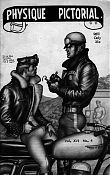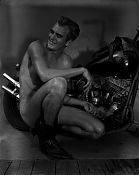Tom, Bob, and the Boys: Queering Midcentury Americana
by Ryan Wong on January 8, 2014

Physique Pictorial Volume 16 Number 4, February 1968. Cover by Tom of Finland (Touko Laaksonen). (with permission of Bob Mizer Foundation, Inc.)
LOS ANGELES — Bob Mizer and Tom of Finland are to queer pop culture something like Picasso and Braque are to 20th-century abstraction: shocking then but still rich and surprising. Side-by-side at MOCA Los Angeles’s Pacific Design Center, we see them codifying an erotica that becomes synonymous with their names, setting down tracks for Andy Warhol, Robert Mapplethorpe, and Mike Kelley in art, Kenneth Anger and John Waters in film. Their eros is narrow and anachronistic, to be sure, but that strangeness has become their magnetism today.
The galleries are filled with hundreds of images of men from the gray flannel suit era: clean-shaven square jaws, straight noses, wavy hair, muscular builds. But the suits are off in favor of in biker or cop or cowboy outfits, or no clothes at all; they strike playful, sexual poses or, in Tom of Finland’s work, are entangled in orgies. These are not the thin, effete men of the mainstream imagination, but archetypes of mid-century American masculinity, the boys next door.
Tom of Finland exploded the charged sexuality he saw under the surface of Americana — in his images, bikers are pulled over by cops and handled a little too roughly, a silhouetted soldier meets a man for a hand job in an archway, the strapping TV repairman is cornered against the set by its owner. They are the same boyish daydreams that pervade porn: banal encounters transformed into sexual fantasy.
Finland’s images are pornographic, to be sure, but they also transcend porn’s single function. His work is a study in the seductiveness of images, the way beauty — in this case the lushness of his graphite and the bold simplicity of his bodies — can normalize the fantastic. Finland codified an entire subculture of leather and biker play; the images and outfits for sale in West Hollywood and the Castro and the West Village could be taken straight from his work.

Bob Mizer, Untitled [Ray Hornsby, Motorcycle], Los Angeles, c. 1957. With permission of Bob Mizer Foundation, Inc.
Next to Tom of Finland, Bob Mizer’s photographs read like rough material, the background research for the artistry. Both artists fill the cover of Physique Pictorial, the magazine published by the Athletic Model Guild (AMG) Mizer founded in 1945. Laws in the 1940s forbade the sale of male pornography, so the AMG functioned as an open secret — erotic near-nudes masked as bodybuilding and wrestling. The Pictorial is filled with lists of models — you could have your favorites — and teaser images with solicitations to mail-order more, presumably racier, pictures. It’s a jarring throwback in our age of internet pornography.
On display are several dozen of Mizer’s working “catalogue boards” — grids of select photographs from his shoots in which men try different poses in different states of undress. At first glance, they look like what Eadweard Muybridge would have done for erotica: scientific, serialized studies of sex appeal. Mizer made hundreds of thousands of these images, pasted into scores of boards, over his fifty year career. You see him seeking that certain turn of the torso, that mischievous grin, that he knew would resonate with his subscribers.
Some of the inspiration photographs from Finland’s studio are also on display. Alongside cutouts of male models, we find images of Che Guevara, Muhammad Ali, and Marlon Brando. But Finland is not interested in them as cultural and political figures; in his eye, among these other men, they are reduced to their handsomeness.
Finland and Mizer shared a connoisseurship for a certain male form. The bodies on view are almost all white and male. One of the few female characters in the exhibition appears in a Tom of Finland serial, a voluptuous beach-goer who is left by her male companion to join an all-male orgy. What emerges is a fantasy universe spun from mid-century America in all its conservatism. We know today that queer bodies are of all genders and shapes and races. We could denounce Mizer and Finland for their narrowness, certainly, but they are much more valuable as reminders of a time when queering dominant bodies was a radical act, as early champions and lovers of their sexuality.
Bob Mizer & Tom of Finland continues at the Museum of Contemporary Art, Los Angeles (250 S Grand Ave, Los Angeles) through January 26.
Tagged as: Art & Queer Culture, Bob Mizer, LA MOCA, Tom of Finland